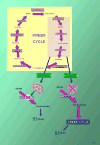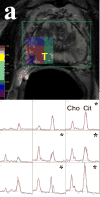New horizons in prostate cancer imaging
- PMID: 18993004
- PMCID: PMC2702141
- DOI: 10.1016/j.ejrad.2008.09.019
New horizons in prostate cancer imaging
Abstract
Prostate cancer is the most common non-cutaneous malignancy among American men. Imaging has recently become more important in detection of prostate cancer since screening techniques such as digital rectal examination (DRE), prostate specific and transrectal ultrasound guided biopsy have considerable limitations in diagnosis and localization of prostate cancer. In this manuscript, we reviewed conventional, functional and targeted imaging modalities used in diagnosis and local staging of prostate cancer with exquisite images.
Figures





























Similar articles
-
[New ultrasound technologies for the diagnostics of prostate cancer].Radiologe. 2011 Nov;51(11):938, 940-6. doi: 10.1007/s00117-011-2178-y. Radiologe. 2011. PMID: 22083309 German.
-
Imaging localized prostate cancer: current approaches and new developments.AJR Am J Roentgenol. 2009 Jun;192(6):1471-80. doi: 10.2214/AJR.09.2527. AJR Am J Roentgenol. 2009. PMID: 19457807 Free PMC article. Review.
-
New agents and techniques for imaging prostate cancer.J Nucl Med. 2009 Sep;50(9):1387-90. doi: 10.2967/jnumed.109.061838. Epub 2009 Aug 18. J Nucl Med. 2009. PMID: 19690043 Free PMC article. Review.
-
Critical evaluation of magnetic resonance imaging targeted, transrectal ultrasound guided transperineal fusion biopsy for detection of prostate cancer.J Urol. 2013 Oct;190(4):1380-6. doi: 10.1016/j.juro.2013.04.043. Epub 2013 Apr 19. J Urol. 2013. PMID: 23608676 Clinical Trial.
-
Prospects in radionuclide imaging of prostate cancer.Prostate. 2012 Aug 1;72(11):1262-72. doi: 10.1002/pros.22462. Epub 2011 Nov 29. Prostate. 2012. PMID: 22127918 Review.
Cited by
-
Image Guided Planning for Prostate Carcinomas With Incorporation of Anti-3-[18F]FACBC (Fluciclovine) Positron Emission Tomography: Workflow and Initial Findings From a Randomized Trial.Int J Radiat Oncol Biol Phys. 2016 Sep 1;96(1):206-13. doi: 10.1016/j.ijrobp.2016.04.023. Epub 2016 Apr 30. Int J Radiat Oncol Biol Phys. 2016. PMID: 27511856 Free PMC article. Clinical Trial.
-
Positron Emission Tomography Radiotracers for Identification of Site of Recurrence in Prostate Cancer After Primary Treatment Failure.Cancers (Basel). 2025 May 21;17(10):1723. doi: 10.3390/cancers17101723. Cancers (Basel). 2025. PMID: 40427220 Free PMC article. Review.
-
Pretargeted immuno-PET and radioimmunotherapy of prostate cancer with an anti-TROP-2 x anti-HSG bispecific antibody.Eur J Nucl Med Mol Imaging. 2013 Sep;40(9):1377-83. doi: 10.1007/s00259-013-2434-7. Epub 2013 May 15. Eur J Nucl Med Mol Imaging. 2013. PMID: 23674207
-
Diagnostic role of fluorodeoxyglucose positron emission tomography-computed tomography in prostate cancer.Oncol Lett. 2014 Jun;7(6):2013-2018. doi: 10.3892/ol.2014.1997. Epub 2014 Mar 24. Oncol Lett. 2014. PMID: 24932281 Free PMC article.
-
Targeting prostate cancer cells in vivo using a rapidly internalizing novel human single-chain antibody fragment.J Nucl Med. 2010 Mar;51(3):427-32. doi: 10.2967/jnumed.109.069492. Epub 2010 Feb 11. J Nucl Med. 2010. PMID: 20150269 Free PMC article.
References
-
- Jemal A, Siegel R, Ward E, et al. Cancer Statistics, 2007. CA Cancer J Clin. 2007;57:43–66. - PubMed
-
- Wang MC, Valenzuela LA, Murphy GP, Chu TM. Purification of a human prostate specific antigen. Invest Urol. 1979;17:159–163. - PubMed
-
- Gretzer MB, Partin AW. PSA markers in prostate cancer detection. Urologic Clinics of North America. 2003;30:677–+. - PubMed
-
- Hricak H, Choyke PL, Eberhardt SC, Leibel SA, Scardino PT. Imaging prostate cancer: A multidisciplinary perspective. Radiology. 2007;243:28–53. - PubMed
Publication types
MeSH terms
Grants and funding
LinkOut - more resources
Full Text Sources
Medical

